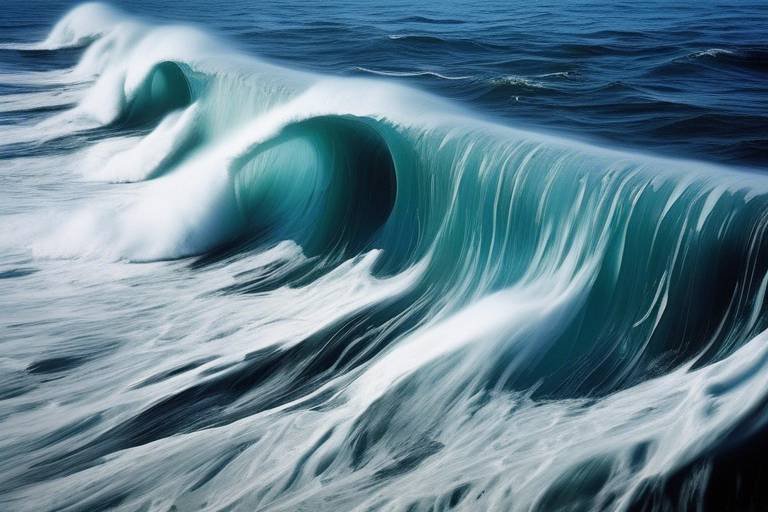The Physics of Tides - Understanding Ocean Behavior
Tides are one of nature's most fascinating phenomena, showcasing the intricate dance between celestial bodies and our planet's oceans. Have you ever stood by the shore, mesmerized by the rhythmic rise and fall of the water? This ebb and flow, known as tides, is not just a random occurrence; it is a predictable result of gravitational forces exerted by the moon and the sun. Understanding the physics behind tides is crucial, not only for marine navigation but also for appreciating the delicate balance of marine ecosystems that thrive in these changing environments.
The gravitational pull of the moon is the primary driver of tidal movements. As the moon orbits the Earth, its gravitational force pulls the water towards it, creating a bulge on the side of the Earth facing the moon. But that's not the whole story! There's also a second bulge on the opposite side of the Earth, created by the centrifugal force resulting from the Earth-moon system's rotation. This dynamic interaction between the moon's pull and the Earth's rotation leads to the familiar cycle of high and low tides.
But wait, there's more! The sun, despite being much farther away, also plays a significant role in shaping our tides. Although the sun's gravitational force is less potent than that of the moon, it still contributes to the overall tidal patterns. When the sun, moon, and Earth align—during full moons and new moons—we experience what are known as spring tides, which produce higher high tides and lower low tides. Conversely, during the first and third quarters of the moon, when the sun and moon are at right angles relative to the Earth, we encounter neap tides, characterized by a smaller tidal range.
Understanding tides is not just an academic exercise; it has real-world implications. Coastal communities rely on tidal patterns for fishing, shipping, and recreation. For instance, fishermen often plan their trips based on tidal schedules, as certain species are more active during specific tidal phases. Similarly, mariners must navigate their vessels wisely, taking into account the tidal range to avoid grounding during low tide.
In summary, the physics of tides is a complex interplay of gravitational forces, celestial alignments, and Earth's rotation. By grasping these principles, we can better appreciate the natural rhythms of our oceans and their profound impact on life both in the sea and along our coastlines. So next time you're at the beach, take a moment to consider the gravitational ballet occurring above your head, influencing the very waters you enjoy!
- What causes tides? Tides are primarily caused by the gravitational pull of the moon and the sun on Earth's oceans.
- How often do tides occur? Tides typically occur twice daily, resulting in a cycle of high and low tides.
- What are spring and neap tides? Spring tides occur when the sun and moon are aligned, producing higher high tides. Neap tides happen when they are at right angles, resulting in lower tidal ranges.
- How do tides affect marine life? Tides play a critical role in marine ecosystems, influencing feeding patterns, breeding cycles, and habitat availability for various species.

[The Gravitational Forces Behind Tides]
The dance of the tides is a mesmerizing spectacle that captivates many, but what truly lies behind this rhythmic movement of ocean waters? At the heart of this phenomenon are the gravitational forces exerted by the moon and the sun. You see, while we often think of the moon as a celestial body that merely lights up our night sky, it plays a pivotal role in shaping our oceans. The gravitational pull of the moon creates a bulge in the Earth's water, leading to high tides. Conversely, the areas perpendicular to this bulge experience low tides. Isn't it fascinating how something so far away can influence our planet in such a profound way?
To break it down further, let's consider the sun's role in this cosmic ballet. Although the sun is approximately 400 times farther away from the Earth than the moon, its massive size means that it still has a significant gravitational effect on our oceans. In fact, the sun's gravitational pull can either enhance or diminish the moon's influence, leading to what we call spring tides and neap tides. During spring tides, which occur when the sun and moon are aligned, we experience higher high tides and lower low tides. On the flip side, neap tides occur when the sun and moon are at right angles to each other, resulting in lower high tides and higher low tides.
Here's a simple breakdown of how these forces interact:
- Moon's Influence: The moon's gravitational pull is the primary driver of tidal movements.
- Sun's Influence: The sun's gravity also plays a role, albeit a secondary one, affecting the height and timing of tides.
- Alignment: The alignment of the sun and moon can lead to variations in tidal ranges.
Understanding these gravitational forces not only enhances our knowledge of tides but also sheds light on their broader implications for marine ecosystems. For instance, the cyclical nature of tides influences nutrient distribution in coastal waters, which in turn affects the entire food web. As tides rise and fall, they bring with them a wealth of nutrients that sustain various marine life forms, from the smallest plankton to the largest whales. So, the next time you watch the waves lapping at the shore, remember that you are witnessing the powerful forces of the universe at work!

[Types of Tides]
Tides are not just simple waves; they are a fascinating display of the gravitational dance between the Earth, moon, and sun. Understanding the types of tides is essential for anyone interested in marine science, navigation, or even just planning a day at the beach. Tides can be classified into several categories based on their frequency and the number of high and low tides that occur in a lunar day. The main types of tides include diurnal, semi-diurnal, and mixed tides. Each type has its own unique characteristics influenced by geographical location and the alignment of celestial bodies.
Diurnal tides are characterized by a single high tide and a single low tide each lunar day. This means that in places where diurnal tides occur, you can expect the water level to rise and fall just once in a 24-hour cycle. These tides are most prevalent in regions like the Gulf of Mexico and parts of Southeast Asia, where the geography allows for this unique tidal pattern. Understanding diurnal tides is crucial for local fishermen and marine biologists, as the timing of these tides can significantly impact marine life and fishing activities.
On the other hand, semi-diurnal tides consist of two high tides and two low tides each lunar day, creating a more predictable and rhythmic pattern. These tides are common along the Atlantic coast of the United States and most of Europe. The semi-diurnal nature of these tides allows for a greater variety of tidal conditions, making it easier for coastal communities to adapt their activities to the rising and falling waters. The tidal range—the vertical difference between high and low tides—tends to be more consistent in these areas, providing a stable environment for marine ecosystems.
Then we have mixed tides, which are a combination of both diurnal and semi-diurnal tides. In these regions, you may experience two high tides and two low tides in a lunar day, but they are not of equal height. Mixed tides can be found along the Pacific coast of the United States and parts of Canada. The complexity of mixed tides can create unique challenges for navigation and coastal management, as the variations in tidal heights can affect everything from boating safety to the behavior of marine organisms.
To summarize, the types of tides can be categorized as follows:
- Diurnal Tides: One high and one low tide each lunar day.
- Semi-Diurnal Tides: Two high and two low tides each lunar day.
- Mixed Tides: A combination of diurnal and semi-diurnal, with varying heights.
Understanding these tidal patterns is not just an academic exercise; it has real-world implications. For instance, fishermen must time their outings based on tidal movements, and coastal planners need to consider how tides affect shoreline erosion and habitat availability. The interplay of these different types of tides creates a dynamic environment that supports a rich diversity of marine life, making it crucial for us to respect and protect these ecosystems.

[Diurnal Tides]
When we talk about diurnal tides, we are referring to a fascinating phenomenon that occurs in certain coastal regions, characterized by a single high tide and a single low tide each lunar day. Imagine the ocean as a giant pendulum, swinging back and forth; this is similar to how diurnal tides operate, but instead of a simple swing, they are influenced by the gravitational forces of the moon and the sun. These tides can be quite predictable, making them essential for various marine activities and coastal navigation.
Diurnal tides typically occur in areas where the geography and ocean floor shape allow for such patterns. For instance, locations like the Gulf of Mexico and parts of the Caribbean Sea experience these tides prominently. The unique characteristics of diurnal tides are not just a matter of timing; they also affect the amplitude, or height, of the tides. In some regions, the difference between high tide and low tide can be quite dramatic, leading to significant changes in the coastal landscape.
One of the most intriguing aspects of diurnal tides is their timing. Each lunar day lasts about 24 hours and 50 minutes, which means that the timing of high and low tides shifts slightly each day. This gradual change can be likened to a slow dance, where the ocean rhythmically rises and falls, creating a mesmerizing spectacle that has captivated humans for centuries. The interplay between the moon's position and the Earth's rotation is what ultimately determines the timing of these tides.
Moreover, the impact of diurnal tides extends beyond just the ocean's surface. They play a crucial role in shaping coastal ecosystems. For example, during low tide, vast expanses of the seabed are exposed, allowing marine life to thrive in the intertidal zones. Organisms such as crabs, mollusks, and various species of fish rely on these tidal changes for feeding and breeding. The unique conditions that arise during diurnal tides create a dynamic environment that supports a rich diversity of marine life.
In summary, diurnal tides are a remarkable aspect of our ocean's behavior, driven by the gravitational forces exerted by the moon and sun. Their predictable nature, timing, and significant impact on coastal ecosystems make them a vital area of study for marine biologists and oceanographers alike. Understanding diurnal tides not only enhances our knowledge of ocean behavior but also informs human activities, from fishing to coastal planning.
- What causes diurnal tides? Diurnal tides are primarily caused by the gravitational pull of the moon and, to a lesser extent, the sun.
- Where can diurnal tides be observed? Diurnal tides are most commonly observed in areas like the Gulf of Mexico and parts of Southeast Asia.
- How do diurnal tides affect marine life? Diurnal tides create intertidal zones that are crucial for feeding and breeding for many marine species.
- Can diurnal tides be predicted? Yes, diurnal tides follow a predictable pattern based on the lunar cycle, making them relatively easy to forecast.

[Characteristics of Diurnal Tides]
Diurnal tides are fascinating phenomena that occur in certain coastal regions, characterized by a single high tide and a single low tide each lunar day. This unique pattern is primarily influenced by the gravitational forces exerted by the moon, which leads to a rhythmic rise and fall of sea levels. One of the most striking features of diurnal tides is their timing; they typically occur approximately every 24 hours and 50 minutes, which is the duration of a lunar day. This slight difference from the solar day can lead to varying tidal schedules, making it essential for those who engage in coastal activities to stay informed.
The amplitude, or the height difference between high and low tides, can also vary significantly in diurnal tides. In some regions, the tidal range can be quite pronounced, resulting in dramatic shifts in water levels that can affect local ecosystems and human activities. For example, in areas with a high tidal range, such as the Gulf of Mexico, the water can rise several feet during high tide and drop just as dramatically during low tide. This fluctuation is not just a spectacle; it plays a crucial role in the life cycles of marine organisms, including fish and crustaceans, which rely on specific tidal conditions for breeding and feeding.
Another interesting aspect of diurnal tides is their geographical distribution. They are most commonly found in regions where the coastline is oriented in a particular way, allowing the tidal forces to interact effectively with the land. For instance, the diurnal tide is prevalent in places like the northern coast of Alaska and parts of Southeast Asia. These regions experience a unique tidal rhythm that shapes their marine ecosystems and influences local fishing practices.
In summary, the characteristics of diurnal tides highlight their importance not only in understanding ocean behavior but also in appreciating the delicate balance of coastal ecosystems. The interaction of gravitational forces, timing, and geographical factors creates a complex yet beautiful dance of the sea that has captivated humans for centuries. Understanding these tides is essential for anyone involved in marine activities, as they can significantly impact navigation, fishing, and coastal management.

[Examples of Diurnal Tides]
When we talk about diurnal tides, we are referring to a fascinating phenomenon where there is only one high tide and one low tide each lunar day. This unique tidal pattern can significantly influence the marine environments where it occurs. One of the most well-known examples of diurnal tides can be found in the Gulf of Mexico. Here, the tidal cycle is primarily diurnal, which means that the coastal areas experience a single high tide followed by a single low tide approximately every 24 hours. This distinct rhythm affects not only the water levels but also the behavior of marine life.
In the Gulf of Mexico, the timing of these tides is influenced by several factors, including the position of the moon and the geographical features of the coastline. For instance, the Florida Keys experience diurnal tides, which create unique habitats for various species. The shallow waters in these areas can lead to dramatic changes in salinity and temperature, impacting the distribution of marine organisms.
Another notable example can be found in parts of Southeast Asia, particularly around the coast of Thailand. The diurnal tides here can create stunning visual effects, exposing vast stretches of sandy beach during low tide. This phenomenon not only attracts tourists but also plays a crucial role in local fishing practices, as fishermen often time their activities around these tidal changes.
To further illustrate the impact of diurnal tides, consider the following table that summarizes key locations where diurnal tides are prevalent:
| Location | Characteristics | Impact on Marine Life |
|---|---|---|
| Gulf of Mexico | Single high and low tide daily | Affects fish spawning and feeding patterns |
| Florida Keys | Shallow waters with significant tidal changes | Impacts habitat availability for various species |
| Southeast Asia (Thailand) | Exposed beaches during low tide | Influences local fishing activities |
In conclusion, understanding the examples of diurnal tides helps us appreciate the complex interplay between gravitational forces and coastal ecosystems. These tides not only shape the physical landscape but also play a critical role in the life cycles of marine organisms. The unique characteristics of diurnal tides in different regions highlight the importance of local geography and its influence on ocean behavior.
- What causes diurnal tides? Diurnal tides are primarily caused by the gravitational pull of the moon, which affects water levels differently depending on the location.
- Where can I observe diurnal tides? You can observe diurnal tides in places like the Gulf of Mexico and certain areas of Southeast Asia, such as Thailand.
- How do diurnal tides affect marine life? Diurnal tides influence the availability of habitats and resources, which can affect feeding, spawning, and overall behavior of marine species.

[Semi-Diurnal Tides]
Semi-diurnal tides are a fascinating aspect of our oceanic world, characterized by the occurrence of two high tides and two low tides each lunar day. This rhythmic dance of water is not just a beautiful sight; it plays a crucial role in shaping coastal ecosystems and influencing human activities. Imagine the ocean as a giant heartbeat, pulsing in and out, with each tide bringing life and energy to the shore. But what exactly causes these tides to behave in such a predictable manner? The answer lies in the gravitational forces exerted by the moon and the sun, along with the unique geographical features of our planet.
In regions where semi-diurnal tides dominate, the timing and height of these tides can vary significantly due to several factors, including the alignment of celestial bodies and local topography. For instance, when the moon is directly overhead, we experience a high tide, while the opposite side of the Earth also sees a high tide due to the gravitational pull of the moon. This creates a fascinating equilibrium that supports a diverse range of marine life. The interplay of these forces can be likened to a well-rehearsed orchestra, where each instrument plays its part to create a harmonious sound.
One of the most interesting aspects of semi-diurnal tides is their tidal range, which refers to the vertical difference between high and low tides. This range can be influenced by various factors, including the geographical location and the shape of the coastline. For example, in some areas, the tidal range can be quite pronounced, leading to dramatic changes in the coastal landscape. In contrast, other regions may experience minimal fluctuations, resulting in a more stable shoreline. To illustrate this, consider the following table that compares tidal ranges in different locations:
| Location | Tidal Range (in meters) |
|---|---|
| Bay of Fundy, Canada | 16.3 |
| Gulf of Mexico | 0.5 - 1.0 |
| San Francisco Bay, USA | 2.5 |
| English Channel, UK | 5.0 |
These variations in tidal range can have profound implications for coastal habitats. For example, in areas with a high tidal range like the Bay of Fundy, the exposure of tidal flats creates rich feeding grounds for birds and other wildlife. Conversely, in regions with minimal tidal fluctuations, the marine life may have adapted to a more stable environment. This adaptability showcases the incredible resilience of nature, as species evolve to thrive in the tides that define their existence.
Moreover, understanding semi-diurnal tides is essential for various human activities, from fishing and boating to coastal development and environmental conservation. Fishermen often rely on tidal patterns to determine the best times for catching specific species, while coastal planners must consider tidal influences when designing infrastructure. In essence, the knowledge of these tides is not just academic; it has real-world applications that can impact livelihoods and ecosystems alike.
As we continue to study and understand the behavior of semi-diurnal tides, we unlock the secrets of our oceans and their intricate systems. The tides serve as a reminder of the interconnectedness of all life forms and the delicate balance that sustains our planet. So, the next time you visit the beach and watch the waves roll in and out, take a moment to appreciate the powerful forces at play beneath the surface.
- What causes semi-diurnal tides?
Semi-diurnal tides are primarily caused by the gravitational pull of the moon and the sun, along with the rotation of the Earth. - How do semi-diurnal tides differ from diurnal tides?
Semi-diurnal tides have two high and two low tides each lunar day, while diurnal tides have only one of each. - Where are semi-diurnal tides most common?
Semi-diurnal tides are commonly found along the Atlantic coast of North America and parts of Europe. - How do tides affect marine life?
Tides create varying habitats in coastal areas, influencing feeding, breeding, and migration patterns of marine species.

[The Role of the Sun]
The sun, while often overshadowed by the moon in discussions about tides, plays a critical role in the complex dance of ocean behavior. Its gravitational pull, although weaker than that of the moon due to the vast distance, still exerts a notable influence on the tides we observe daily. To grasp the full picture of how tides work, it’s essential to understand this solar contribution. Imagine the sun as a powerful magnet, pulling not just on the earth but also on the water that envelops it. This interaction creates a dynamic relationship between the sun, moon, and Earth, leading to fascinating tidal phenomena.
When the sun, moon, and Earth align, we experience what are known as spring tides. These occur during the full moon and new moon phases, when the gravitational forces of the sun and moon combine to produce higher high tides and lower low tides. The result? A significant increase in the tidal range, which can have profound effects on coastal ecosystems. Think of spring tides as the ocean's way of flexing its muscles, showcasing its power and ability to reshape shorelines.
Conversely, during the first and third quarters of the moon, we experience neap tides. During these times, the sun and moon are at right angles relative to the Earth, which diminishes the gravitational pull on the oceans. The result is a smaller tidal range, leading to less dramatic changes in water levels. Neap tides can be likened to a gentle sigh of the ocean, a soft reminder of its more subdued nature. Understanding these cycles is crucial for fishermen, sailors, and anyone who interacts with the sea, as they dictate the best times for various activities.
To illustrate the differences between spring and neap tides, consider the following table:
| Tide Type | Occurrence | Characteristics |
|---|---|---|
| Spring Tide | Full Moon and New Moon | Higher high tides and lower low tides |
| Neap Tide | First and Third Quarter Moon | Lower high tides and higher low tides |
In addition to these tidal phenomena, the sun also affects the tidal range, which is the vertical difference between high and low tides. The sun’s position relative to the Earth can either enhance or diminish this range. For instance, during spring tides, the tidal range is at its maximum because of the combined gravitational forces. Conversely, during neap tides, the range is minimized. This fluctuation can have various implications for coastal habitats, influencing the distribution of marine species and the health of ecosystems.
In summary, while the moon is often the star of the tidal show, the sun's gravitational influence is undeniably significant. Together, they create a rhythmic pattern of tides that not only shapes our coastlines but also supports a myriad of marine life. Understanding this relationship empowers us to appreciate the intricate balance of our planet's natural systems.
- How do the sun and moon influence tides?
The sun and moon exert gravitational forces on Earth, causing the water to bulge and create high and low tides. - What are spring and neap tides?
Spring tides occur when the sun and moon align, resulting in higher high tides. Neap tides happen when the sun and moon are at right angles, leading to lower high tides. - Why are tides important?
Tides play a crucial role in marine ecosystems, affecting nutrient distribution, breeding cycles of marine life, and coastal navigation.

[Spring and Neap Tides]
Spring and neap tides are fascinating phenomena that arise from the intricate dance between the moon and the sun. These tides are not just random fluctuations in the ocean; they are predictable events that can be traced back to the gravitational forces exerted by these celestial bodies. When the sun, moon, and Earth align, we experience what are known as **spring tides**. During this time, the gravitational pull of the moon and the sun work in tandem, resulting in the highest high tides and the lowest low tides. It's like a cosmic tug-of-war that pulls the ocean's water to its peak levels, creating a dramatic effect along coastlines.
Conversely, **neap tides** occur when the moon and sun are at right angles to each other in relation to the Earth. This arrangement leads to a decrease in the gravitational pull on the oceans, resulting in lower high tides and higher low tides. Imagine the ocean as a giant trampoline; when the sun and moon pull together, the water bounces high, but when they pull apart, the bounce is less pronounced. This cyclical pattern of spring and neap tides can be observed throughout the lunar month, creating a rhythm that has profound effects on marine life and coastal ecosystems.
The timing of these tides is critical, especially for those who rely on the ocean for their livelihoods. Fishermen, for example, often take these tidal changes into account when planning their trips. Spring tides can bring in nutrient-rich waters, making it an ideal time for fishing, while neap tides might not yield as bountiful a catch. Understanding these patterns can mean the difference between a successful day at sea and an empty net.
To give you a clearer picture of how these tides work, here's a simple table showing the relationship between the moon's phases and the types of tides experienced:
| Moon Phase | Type of Tide | Characteristics |
|---|---|---|
| New Moon | Spring Tide | Highest high tides and lowest low tides |
| First Quarter | Neap Tide | Lower high tides and higher low tides |
| Full Moon | Spring Tide | Highest high tides and lowest low tides |
| Last Quarter | Neap Tide | Lower high tides and higher low tides |
In summary, spring and neap tides are more than just scientific terms; they are vital elements of our planet's natural rhythm. By understanding these tidal patterns, we can better appreciate the incredible forces at play in our oceans and how they affect everything from marine ecosystems to human activities along the coast.
Frequently Asked Questions
- What causes spring and neap tides? Spring and neap tides are caused by the gravitational pull of the moon and the sun on the Earth's oceans.
- How often do spring and neap tides occur? Spring and neap tides occur in a predictable cycle, approximately every two weeks, aligned with the lunar phases.
- What is the difference between spring tides and neap tides? Spring tides have higher high tides and lower low tides, while neap tides have lower high tides and higher low tides.

[Tidal Range]
The tidal range is a fascinating aspect of ocean behavior that refers to the vertical difference between the highest tide (high tide) and the lowest tide (low tide) in a specific location. This range can vary significantly from one area to another, influenced by a multitude of factors including geography, the alignment of the sun and moon, and local weather conditions. Understanding tidal range is crucial not only for marine ecosystems but also for human activities such as fishing, shipping, and coastal development.
To put it simply, think of the tidal range as the ocean's way of breathing. Just as we inhale and exhale, the tides rise and fall, creating a rhythm that is essential for life in and around the sea. In some locations, this breath is deep and pronounced, while in others, it's shallow and subtle. For instance, areas with a large tidal range, like the Bay of Fundy in Canada, can experience differences of over 16 meters (about 53 feet) between high and low tides. In contrast, regions with a smaller tidal range, such as the Caribbean, may see only a meter or so difference.
Several factors contribute to the variation in tidal range:
- Geographical Features: Coastal topography, such as bays, estuaries, and inlets, can amplify or diminish tidal ranges. Narrow bays can funnel water, leading to higher tides, while wide open coastlines may experience smaller fluctuations.
- Earth-Moon-Sun Alignment: The gravitational pull of the moon is the primary driver of tides, but the sun's influence is significant as well. When the sun and moon align (during full and new moons), we experience spring tides, which have the highest tidal ranges. Conversely, during the first and last quarter moons, we experience neap tides, which result in the lowest tidal ranges.
- Weather Conditions: Atmospheric pressure, wind, and precipitation can also affect tidal range. For example, strong winds can push water towards the shore, temporarily increasing the tidal range.
Understanding the tidal range is vital for various reasons. It impacts marine ecosystems, as many organisms depend on the tidal cycle for feeding, breeding, and migration. For instance, intertidal zones, which are areas that are exposed during low tide and submerged during high tide, are rich in biodiversity and serve as crucial habitats for many species. Additionally, knowing the tidal range is essential for safe navigation in coastal waters. Fishermen, boaters, and coastal developers must consider tidal ranges to avoid grounding and to optimize their activities.
In summary, the tidal range is more than just a measurement; it's a dynamic component of our planet's systems. By recognizing its importance, we can better appreciate the intricate balance of our oceans and the life they support. As we continue to study and understand these patterns, we not only gain insight into the natural world but also enhance our ability to coexist with it.
What is the largest tidal range in the world?
The Bay of Fundy in Canada holds the record for the largest tidal range, with differences exceeding 16 meters (53 feet) in some areas.
How do tidal ranges affect marine life?
Tidal ranges create intertidal zones that are critical for many species, providing habitats for feeding and breeding. The rise and fall of tides influence nutrient availability and the movement of marine organisms.
Can tidal ranges change over time?
Yes, tidal ranges can change due to factors such as climate change, sea-level rise, and alterations in coastal geography. Long-term monitoring is essential to understand these changes.
Frequently Asked Questions
- What causes tides?
Tides are primarily caused by the gravitational pull of the moon and the sun on Earth’s oceans. This gravitational force creates bulges of water, leading to high and low tides as the Earth rotates.
- What are the different types of tides?
There are three main types of tides: diurnal, semi-diurnal, and mixed tides. Diurnal tides have one high and one low tide each lunar day, semi-diurnal tides have two high and two low tides, and mixed tides exhibit characteristics of both.
- Where are diurnal tides most commonly found?
Diurnal tides are most commonly found in regions like the Gulf of Mexico, where the unique geographical features contribute to their single high and low tide cycle.
- How do spring and neap tides differ?
Spring tides occur when the sun, moon, and Earth are aligned, leading to higher high tides and lower low tides. Neap tides happen when the sun and moon are at right angles to each other, resulting in a smaller tidal range.
- What factors influence tidal range?
The tidal range is influenced by several factors, including the position of the moon and sun, the shape of the coastline, and local geographical features. These elements can significantly affect the height difference between high and low tides.
- How do tides affect marine ecosystems?
Tides play a crucial role in marine ecosystems by influencing nutrient distribution, breeding cycles, and the availability of habitats for various marine species. The ebb and flow of tides help sustain diverse life forms in coastal areas.
- Can human activities impact tides?
While human activities do not directly change the gravitational forces that cause tides, they can affect tidal patterns through coastal development, dam construction, and other alterations to natural waterways.
- Why is it important to understand tides?
Understanding tides is essential for navigation, fishing, and coastal management. It helps in predicting water levels, ensuring safety for marine activities, and protecting coastal ecosystems from human impact.



















